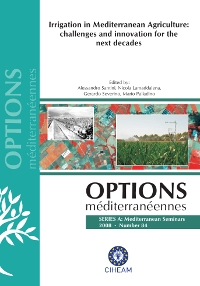| Article précédent | p. 161-167 | Article suivant |
Terrain and climate change impact on WUE of durum wheat in a semi-arid hilly catchment
Until now, any simulation model has investigated in detail the terrain effects (slope, elevation and azimuth effects) on the crop growth in function of climate changes. The focus of this paper is to relate predicted yields of wheat crops to topographic characteristics, analysing the vulnerability in future scenarios with respect to crop cultivated in plane in a semi-arid region in South Italy. The presented simulation is based on the model STAMINA, which is the result of a European project (EU-QLK-5- CT-2002-01313) where a risk assessment for arable agriculture in hilly landscape has been done in detail in the final report of the project. This complex cropping system model, integrating spatial information, simulates agro-meteorology, hydrology, crop development and photosynthesis in hilly terrain, deriving, among others variables, Agro-Ecological Indicators (AEI) for aiding decision makers to improve sustainable farming at the catchment scale. Among the AEI indicators obtainable by STAMINA model, the WUE, defined by the ratio of yield and cumulative actual evapotranspiration, has been analysed to show how the spatial heterogeneity of the landscape affected its distribution in time and space. Moreover, a study on how management practices could mitigate negative impacts of climate change and topography is done.
Jusqu'à présent, aucun modèle de simulation n'a exploré en détail les effets du terrain (pente, exposition et azimut) sur la croissance des plantes en fonction des changements climatiques. Ce travail se focalise sur la prévision du rendement du blé en fonction des caractéristiques topographiques, en analysant sa vulnérabilité dans les scénarios futurs dans une plaine de l'Italie du sud. La simulation présentée se base sur un modèle (STAMINA) développé dans le cadre d'un projet européen (EUQLK- 5-CT-2002-01313), où la prévision des risques pour les cultures en terrain collinaire a été élaborée. Ce modèle intègre un système cultural, des informations spatiales, l'agrométéorologie, l'hydrologie, la croissance et la photosynthèse en terrains en pente, pour fournir des indicateurs agroécologiques (AEI) afin de contribuer à l'amélioration de l'agriculture à l'échelle régionale. L'efficience d'utilisation de l'eau (WUE), définie comme le rapport entre le rendement et l'évapotranspiration réelle cumulée, a été analysée pour montrer comment sa distribution dans le temps et l'espace est influencée par l'hétérogénéité du terrain. De plus, les pratiques culturales pour réduire les effets du changement climatique et de la pente ont été étudiées.
- [ Afficher ]
- [ Télécharger ]
- [ Exporter la citation ]
Vous pouvez télécharger la citation au format :
- [ Imprimer ]
-
Mots-clés
BLE DUR, CHANGEMENT CLIMATIQUE, EFFICIENCE D'UTILISATION DE L'EAU, MODELE DE SIMULATION, PRATIQUE CULTURALE, RENDEMENT DES CULTURES, TERRE EN PENTE, TOPOGRAPHIE, TRITICUM DURUM, ZONE ARIDECiter cet article
Ferrara R.M., Introna M., Martinelli N., Rana G. Terrain and climate change impact on WUE of durum wheat in a semi-arid hilly catchment. In : Santini A. (ed.), Lamaddalena N. (ed.), Severino G. (ed.), Palladino M. (ed.). Irrigation in Mediterranean agriculture: challenges and innovation for the next decades. Bari : CIHEAM, 2008. p. 161-167. (Options Méditerranéennes : Série A. Séminaires Méditerranéens; n. 84). International Conference on Irrigation in Mediterranean Agriculture: Challenges and Innovation for the Next Decades, 2008/06/17-18, Naples (Italy). http://om.ciheam.org/om/pdf/a84/00800962.pdf



